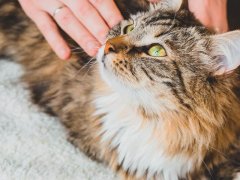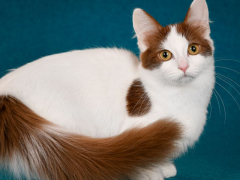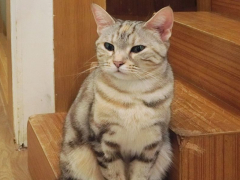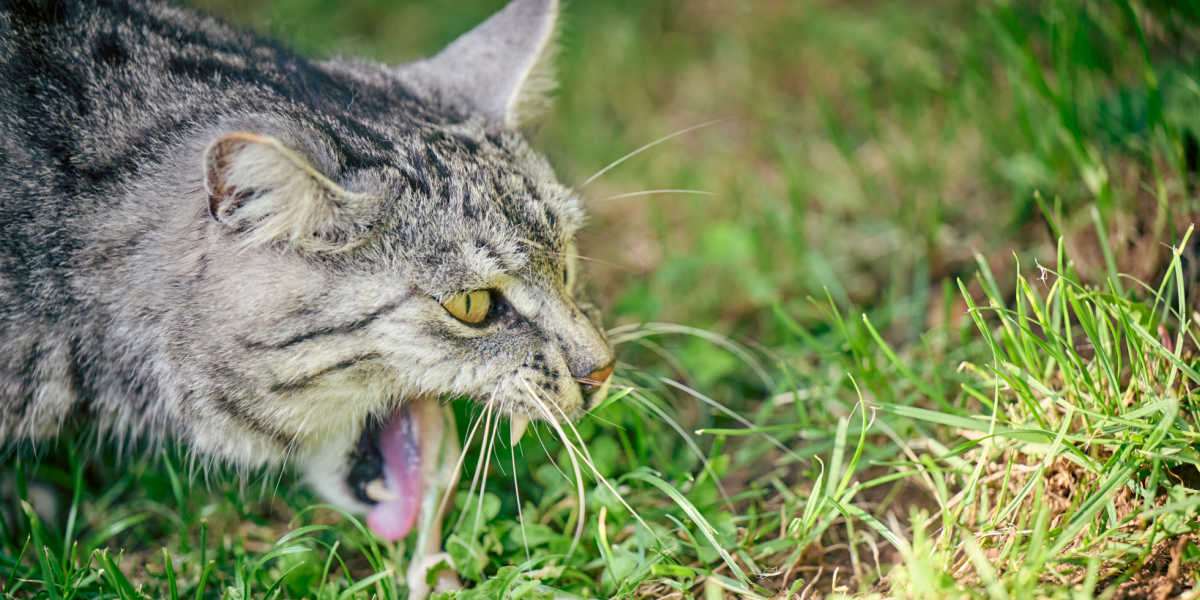
It’s never fun to see (or hear) your cat throwing up undigested food. It sounds gross, and there’s nothing pleasant about stepping in a freshly left pile of damp kibble. In this article, you’ll learn the differences between vomiting and regurgitation, the causes of both in cats, treatment and prevention, and some frequently asked questions.
Vomiting vs. Regurgitation: Which One Am I Seeing?

Before getting into what to do about your cat throwing up undigested food, it’s important to first know the difference between the two types of throwing up. Are you seeing vomiting or regurgitation?
Vomiting
Vomiting expels the contents of the stomach and of the early small intestine. Vomit usually contains some amount of at least partially digested food. It is also typically accompanied by bile, a yellow or green fluid that is part of digestion in the small intestine.
When cats vomit, it’s usually a pretty dramatic event. They’ll act anxious or on edge, sometimes lick their lips, then hunker down towards the floor. Their stomach will start to contract in and out, which is very noticeable in cats, often resembling a series of full-body spasms before retching and ejecting their stomach contents. Some cats also vocalize and make odd noises prior to vomiting.
Vomiting occurs shortly after eating, or even a couple hours later.
Regurgitation
Regurgitation looks a bit different from vomiting and is typically less dramatic. It only truly involves food being expelled from the mouth, pharynx (throat area), and esophagus. Always occurring shortly after eating, regurgitation involves a more passive expulsion of food that looks very undigested though possibly covered with a little mucus.
Compared to the spasms and drama of vomiting, regurgitation is often accompanied by a little cough or gag, but it otherwise appears as though the food just sort of popped out. The bolus of food expelled often has a cylindrical or tube-like shape.
By and large, if you see your cat throwing up undigested food, they are actually regurgitating, not vomiting.
Also Read: How to Clean Up Cat Vomit In 5 Simple Steps
What Are the Possible Causes of My Cat Throwing Up Undigested Food?
If your cat is regurgitating undigested food, there are several possible causes. Some common reasons include:
- Your cat eats too much: if your cat overeats and surpasses their stomach’s capacity, additional food sitting in the esophagus will come back up.
- Your cat eats too quickly: Eating fast and gulping food also leads to gulping air. Excess air in the stomach and esophagus then leads to food being expelled.
- Your cat is stressed: If a cat is fearful or stressed, especially because of competition for resources with other pets in the home, this often leads to rapid eating and scarfing down food.
- Your cat drinks too much water: A lot of water consumed before or after eating reduces the allowed volume of food in the stomach.
- Inflammation of the esophagus: Esophagitis inhibits the forward motion of the esophagus, which helps food move down into the stomach, leading to spasms of the esophagus. Stomach acid from recurrent vomiting can ironically cause esophagitis, leading to regurgitation as well.
- Inherited diseases of the esophagus: Some animals are born with inherited disorders of motility, or motion, of the esophagus, predisposing them to regurgitation. Megaesophagus is the biggest one, where the esophagus becomes abnormally dilated and its muscles cannot function properly.
- Other acquired diseases of the esophagus: There are many other medical causes of esophageal disease. These include trauma, ulceration, and metabolic or endocrine/hormonal disorders. Megaesophagus can also develop secondary to another cause like a stricture, foreign object, a growth/tumor, or neurologic disease affecting the muscles.
When To Call the Vet
Fortunately, there are some simple remedies to use at home to help with many common causes of regurgitation. This is especially so if your cat is throwing up food because of food-eating behaviors, stress, or anxiety.
Generally, if regurgitation occurs more than two or three times a month and these home remedies aren’t effective, there may be an underlying medical cause. Take your cat to the vet to see if this is the case.
Treatment for Regurgitation in Cats
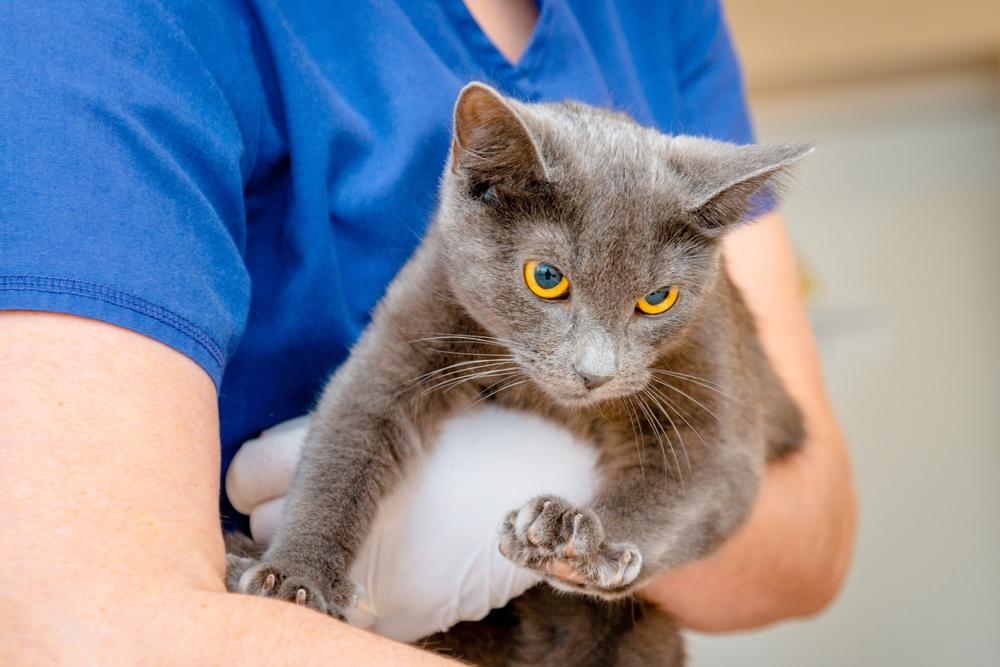
When at-home changes are made and your cat is still frequently throwing up undigested food, it is time to visit the veterinarian.
If you’re not sure if your cat is vomiting or regurgitating, it’s best to start with a veterinary exam. There are many underlying medical causes of both vomiting and regurgitation and it’s best to rule these possibilities out before assuming a behavioral cause is to blame. Review with your vet what you’re seeing in your cat and determine the best way to proceed.
If your cat is regurgitating often, your vet may elect to check for megaesophagus or evidence of a foreign object with an x-ray. Megaesophagus cannot be cured but can be managed depending on the underlying cause.
Regurgitation caused by a stricture, growth, foreign object, or chronic inflammation may require the passage of an endoscope down the esophagus under anesthesia to view the problem. Small growths or objects can be removed through the scope while larger ones may require surgery.
Chronic inflammation or ulceration of the esophagus is often addressed with medications to reduce stomach acid and coat the tissues of the esophagus and stomach to help with healing.
Home Care For Regurgitation
If you’re for sure seeing regurgitation and you see your cat throwing up undigested food as a result of a behavioral issue, here are some at-home approaches to help your cat.
- Slow down your cat’s eating pace. The simplest method is to move food to the outer edges of the bowl so that your cat can’t down the food in one go. Slow feeder bowls and puzzle bowls have also been shown to help reduce regurgitation occurrence.
- Feed smaller meals more frequently. Split your cat’s daily amount of food into three or four meals. If you can’t do this feeding schedule personally, automated feeders are helpful to portion food out at certain times.
- Make your cat hunt for food. Cats are instinctive hunters. Some cat owners actually hide small amounts of food throughout the house for their cats to find. This is a fun and stimulating way for your cat to eat. Cover both ends of a toilet paper roll with tape and cut a small hole in the side. Put several kibbles inside and your cat will have a great time manipulating the toilet paper roll to get their food out!
- Reduce stress with private access to food. In multiple pet households where food competition is an issue, give your cat a quiet, private place to eat. This often reduces frenzied eating behavior.
- Keep food and feeding times consistent. Changing your cat’s food too often and feeding at inconsistent times commonly lead to an upset stomach. Automatic feeders help make feeding times more regular if you can’t be at home to do it in person. New diet changes need to be transitioned to over 1-2 weeks to allow your cat’s digestive system to adjust.
Prevention of Regurgitation in Cats
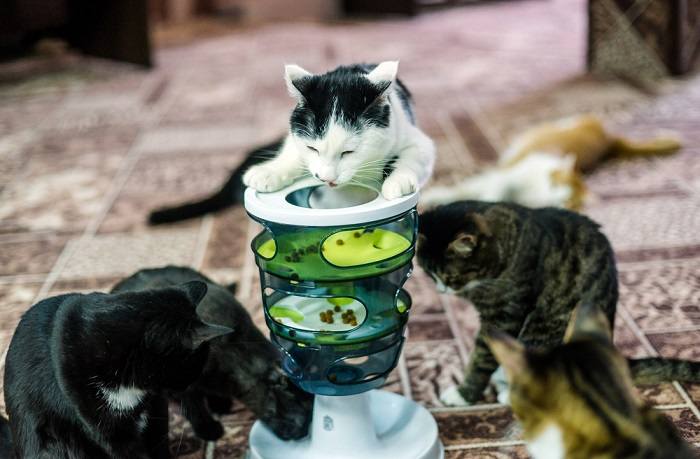
Giving your cat a feeding set-up and schedule that helps them enjoy their food is a great way to prevent regurgitation in the first place.
Some of the at-home therapy strategies for cats also act as prevention for simple and infrequent causes of regurgitation:
- Reduce stress for your cat by giving them a quiet, safe place to enjoy their food.
- Keep meals smaller but more frequent to help with digestion and satiation.
- Slow down eating by spreading the food out around the edges of a bowl or use a slow feeding/puzzle bowl.
Final Thoughts
Regurgitation is the term for your cat throwing up undigested food. This is common in cats, but should still only happen occasionally. In these cases, some at-home remedies help reduce the occurrence. Regurgitation that occurs more often than a couple times a month warrants further investigation from a veterinarian to rule out an underlying medical cause.
Also Read: 10 Subtle Signs Your Cat May Be Sick
-
Dantas LM, Delgado MM, Johnson I, Buffington CT. Food puzzles for cats: Feeding for physical and emotional wellbeing. Journal of Feline Medicine and Surgery. 2016;18(9):723-732. doi:10.1177/1098612X16643753. Accessed May 4, 2023. https://journals.sagepub.com/doi/pdf/10.1177/1098612X16643753
-
Gryzb, K. Cat Regurgitation. PetMD. Published 9/23/2022. Accessed May 4, 2023. https://www.petmd.com/cat/symptoms/cat-regurgitation
-
Lundgren, B. Vomiting or Regurgitation in Dogs and Cats?. Veterinary Partner. Revised and reviewed December 19, 2019. Accessed May 4, 2023. https://veterinarypartner.vin.com/default.aspx?pid=19239&id=4952781
-
Miller, W. Why is My Cat Throwing Up Undigested Food? Petco. Updated January 19, 2023. Accessed May 4, 2023. https://www.petco.com/content/petco/PetcoStore/en_US/pet-services/resource-center/health-wellness/why-is-my-cat-throwing-up-undigested-food.html
-
Zoran, DL. Managing vomiting in cats (Proceedings). DVM360. Published October 1, 2011. Accessed May 4, 2023. https://www.dvm360.com/view/managing-vomiting-cats-proceedings

